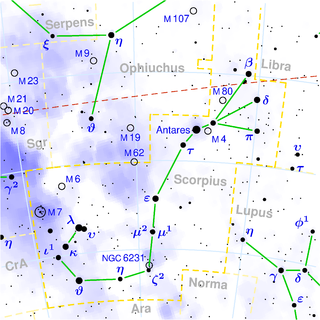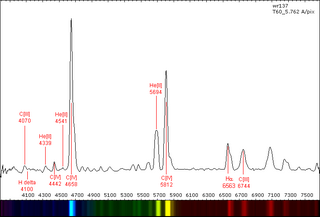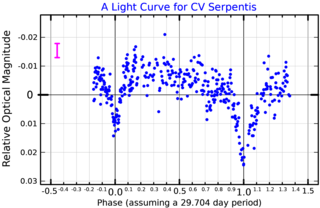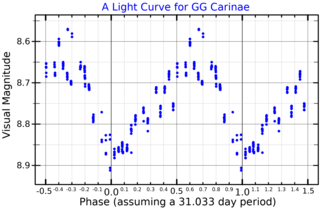
Wolf–Rayet stars, often abbreviated as WR stars, are a rare heterogeneous set of stars with unusual spectra showing prominent broad emission lines of ionised helium and highly ionised nitrogen or carbon. The spectra indicate very high surface enhancement of heavy elements, depletion of hydrogen, and strong stellar winds. The surface temperatures of known Wolf–Rayet stars range from 20,000 K to around 210,000 K, hotter than almost all other kinds of stars. They were previously called W-type stars referring to their spectral classification.

Luminous blue variables (LBVs) are massive evolved stars that show unpredictable and sometimes dramatic variations in their spectra and brightness. They are also known as S Doradus variables after S Doradus, one of the brightest stars of the Large Magellanic Cloud. They are extraordinarily rare, with just 20 objects listed in the General Catalogue of Variable Stars as SDor, and a number of these are no longer considered LBVs.

R136 is the central concentration of stars in the NGC 2070 star cluster, which lies at the centre of the Tarantula Nebula in the Large Magellanic Cloud. When originally named it was an unresolved stellar object but is now known to include 72 class O and Wolf–Rayet stars within 5 parsecs of the centre of the cluster. The extreme number and concentration of young massive stars in this part of the LMC qualifies it as a starburst region.

Westerlund 1 is a compact young super star cluster about 3.8 kpc away from Earth. It is thought to be the most massive young star cluster in the Milky Way, and was discovered by Bengt Westerlund in 1961 but remained largely unstudied for many years due to high interstellar absorption in its direction. In the future, it will probably evolve into a globular cluster.

A hypergiant (luminosity class 0 or Ia+) is a very rare type of star that has an extremely high luminosity, mass, size and mass loss because of its extreme stellar winds. The term hypergiant is defined as luminosity class 0 (zero) in the MKK system. However, this is rarely seen in literature or in published spectral classifications, except for specific well-defined groups such as the yellow hypergiants, RSG (red supergiants), or blue B(e) supergiants with emission spectra. More commonly, hypergiants are classed as Ia-0 or Ia+, but red supergiants are rarely assigned these spectral classifications. Astronomers are interested in these stars because they relate to understanding stellar evolution, especially star formation, stability, and their expected demise as supernovae.

55 Cygni is a blue supergiant star in the constellation Cygnus. It is thought to be a member of the Cygnus OB7 stellar association at about 2,700 light years.

WR 25 is a binary star system in the turbulent star-forming region the Carina Nebula, about 6,800 light-years from Earth. It contains a Wolf-Rayet star and a hot luminous companion and is a member of the Trumpler 16 cluster. The name comes from the Catalogue of Galactic Wolf–Rayet Stars.

V1073 Scorpii is a variable star in the constellation Scorpius. It has a non-Greek Bayer designation of k Scorpii. The star has a blue-white hue and is visible to the naked eye with an apparent visual magnitude that fluctuates around +4.87. Parallax measurements yield a distance estimate of approximately 2,920 ly (896 pc) from the Sun, and it is drifting further away with a radial velocity of +7 km/s. It has an absolute magnitude of −6.8

AH Scorpii is a red supergiant variable star located in the constellation Scorpius. It is one of the largest stars known by radius and is also one of the most luminous red supergiant stars in the Milky Way.
R99 is a star in the Large Magellanic Cloud in the constellation Dorado. It is classified as a possible luminous blue variable and is one of the most luminous stars known.

V915 Scorpii is an orange hypergiant variable star in the constellation Scorpius.

V528 Carinae is a variable star in the constellation Carina.

WR 137 is a variable Wolf-Rayet star located around 6,000 light years away from Earth in the constellation of Cygnus.
WR 111 is a Wolf-Rayet (WR) star in the constellation Sagittarius. It is magnitude 7.8 and lies about 5,150 light-years away. It is one of the brightest and most closely studied WR stars.

HD 151932, also known as WR 78, is a Wolf-Rayet star located in the constellation Scorpius, close to the galactic plane. Its distance is around 1,300 parsecs away from the Earth. Despite being a blue-colored Wolf-Rayet star, it is extremely reddened by interstellar extinction, so its apparent magnitude is brighter for longer-wavelength passbands. HD 151932 lies about 22′ west of the open cluster NGC 6231, the center of the OB association Scorpius OB1; it is not clear whether it is a part of the association or not. With an apparent magnitude of about 6.5, it is one of the few Wolf-Rayet stars that can be seen with the naked eye.

HD 152408, also known as WR 79a, is a Wolf-Rayet star located in the constellation Scorpius, close to the galactic plane. Its distance is around 2,020 parsecs away from the Earth.

CV Serpentis is a binary star system in the equatorial constellation of Serpens. It is a detached eclipsing binary with an orbital period of 29.7 days. The system includes a Wolf–Rayet (WR) star with the identifier WR 113. The system is located at a distance of approximately 6,700 light years from the Sun based on parallax measurements. It is a member of the Serpens OB2 association of co-moving stars.

GG Carinae is a binary star system in the southern constellation of Carina, abbreviated GG Car. It is a variable star with a brightness that fluctuates around an apparent visual magnitude of 8.67, making it too faint to be visible to the naked eye. The distance to this system is approximately 8,000 light years based on parallax measurements.













